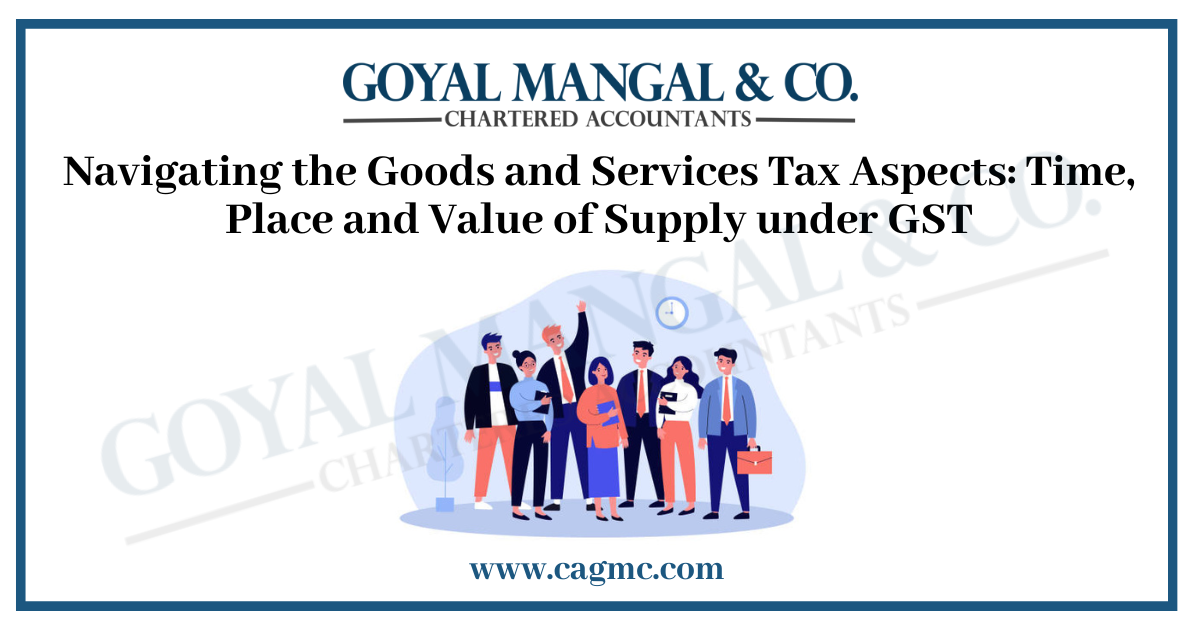
Time, Place, and Value of Supply are the three fundamental pillars of Goods and Services Tax (GST). These keystones indicate at the time of liability arises, where a transaction is deemed to occur, and how the taxable amount is measured. In this article, we will explore the meaning of Time, Place, and Value of Supply under GST, its significance and other aspects of it. Furthermore, provides their implications for businesses and individuals.
|
Table of Content |
Time of Supply under GST in detail discussion
“Time of Supply” is a crucial concept under the Goods and Services Tax (GST) framework, governing when the liability to pay GST arises on a particular transaction. This temporal aspect holds immense importance as it determines the tax period in which the transaction must be reported and the applicable tax rate. Understanding the intricacies of the time of supply is essential for businesses to accurately calculate and comply with their GST obligations.
Determining Time of Supply:
The time of supply differs for goods and services and is determined by specific events:
For Goods:
Date of Invoice: The earlier of the following two events is considered:
- The date on which the supplier issues the invoice.
- The last date by which the supplier is required to issue the invoice under GST laws.
Date of Delivery: The earlier of these two events is considered:
- The date on which the goods are delivered to the recipient or any other person on the direction of the recipient.
- The date on which the recipient acknowledges the receipt of goods in their books of account.
For Services:
Date of Invoice: Similar to goods, the earlier of the following two events is considered:
- The date on which the supplier issues the invoice.
- The last date by which the supplier is required to issue the invoice under GST laws.
Date of Payment: The earlier of these two events is considered:
- The date on which payment is received by the supplier.
- The date on which the recipient records the payment in their books of account.
Exceptions and Special Cases:
The time of supply rules may have exceptions and modifications based on certain scenarios:
- Continuous Supply of Goods or Services: In cases where a supply spans multiple periods and involves successive payments, the time of supply is determined differently. It is either the date of issue of the invoice or the date on which the payment becomes due, whichever is earlier.
- Reverse Charge Mechanism: In cases where the recipient is liable to pay GST under the reverse charge mechanism, the time of supply is the earliest of the date of receipt of goods or services or the date on which payment is made.
- Change in Rate of Tax: If the rate of tax changes between the time of supply and the time of issuance of the invoice, the time of supply is the earlier of the two.
Explain the Place of Supply under GST
“Place of Supply” is a fundamental concept within the GST regime that defines the geographical location where a supply of goods or services is deemed to have occurred. This determination is crucial as it determines the jurisdiction under which the transaction is subject to taxation. Understanding the rules governing the place of supply is essential for businesses to accurately assess their tax obligations and comply with GST regulations.
Determining Place of Supply:
The place of supply rules varies based on whether the supply is classified as an intra-state supply (within the same state/union territory) or an inter-state supply (between different states/union territories). These rules differ for goods and services:
For Goods:
- Intra-State Supply: The place of supply for goods within the same state/union territory is the location where the goods are delivered.
- Inter-State Supply: The place of supply for goods between different states/union territories is the location of the delivery destination.
For Services:
- Intra-State Supply: The place of supply for services within the same state/union territory is the location of the recipient’s address as per the records of the supplier.
- Inter-State Supply: The place of supply for services between different states/union territories is the location of the recipient’s address as per the records of the supplier.
Exceptions and Special Cases:
Several scenarios warrant special considerations:
- Services Relating to Immovable Property: The place of supply for services like real estate transactions or hotel accommodation is determined based on the location of the immovable property.
- Services Directly Connected to Goods: For services closely associated with specific goods, the place of supply is determined based on the location of those goods.
- Supply to Registered Person: If the recipient of a supply is a registered person, the place of supply might be the location of the recipient’s principal place of business, even if the actual supply location is different.
Discussion regarding the Value of Supply under GST
“Value of Supply” is a fundamental concept within the GST framework that pertains to the determination of the taxable value on which the GST is calculated. This value is crucial for calculating the correct amount of GST payable by the supplier and understanding the financial implications of a transaction. Understanding the rules and components that contribute to the value of supply is essential for businesses to accurately assess their tax liabilities and comply with GST regulations.
Components of Value of Supply:
The value of supply of Goods under GST includes not only the actual transaction amount but also certain other considerations that are deemed part of the supply:
- Transaction Value: This is the actual amount paid or payable for the supply of goods or services, including any amount that the recipient is liable to pay, but which has been incurred by the supplier.
- Taxes and Duties: The value of supply includes all taxes, duties, cesses, fees, and charges levied under any law other than the GST Act. However, certain taxes like GST itself, State Cess, and Union Territory Cess are excluded from the value of supply.
- Incidental Expenses: These are expenses directly related to the supply and borne by the supplier but charged separately from the transaction value. Examples include packing charges, freight charges, and insurance charges.
- Discounts: Only those discounts that are established before or at the time of the supply and are linked to the invoices can be deducted from the transaction value.
Significance of Time, Place, and Value of Supply under GST
There is certain significance to each fundamental aspect of GST; however, we are going to discuss it collectively. Thus, here are certain significance of Time, Place, and Value of Supply under GST:
- Tax Revenue Collection: Proper application of time, place, and value of supply rules leads to accurate tax collection, which is crucial for funding government operations and services.
- Business Efficiency: Comprehending and adhering to these concepts helps businesses streamline their operations, make informed financial decisions, and allocate resources more effectively.
- Consumer Protection: The correct application of these concepts ensures that consumers are not overcharged and that taxes are levied fairly, enhancing consumer trust in the tax system.
- Government Accountability: Accurate reporting and adherence to these concepts contribute to the government’s ability to track and manage tax revenue effectively, promoting financial transparency.
Final Discussion
Through the article, the final words are in the GST framework; these three aspects Time, Place, and Value of Supply form a backbone. As these determine the transactions of tax, regulations and reporting. The concept of Time of Supply, dictating when the GST liability arises, ensures accurate tax reporting and efficient cash flow management for businesses. Individually, these concepts shine a light on specific dimensions of the GST landscape, enhancing compliance, transparency, and efficiency. These concepts empower businesses to flourish within the bounds of the law, governments to allocate resources effectively, and economies to thrive on a foundation of trust, and transparency.


